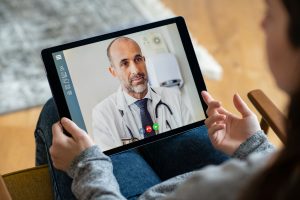This two-part blog series examines the reimagined role of a patient in the new era of healthcare. Patients of today are both empowered and overwhelmed by the enormity of the available data and information as well as the weight of decisions and responsibility they are often required to take on when it comes to their own wellbeing and healthcare in order to ensure the best outcomes, the meaning of which they are also redefining for themselves and their healthcare providers.
This article’s focus is on the origins and current state of the shifts in the healthcare ecosystem and new patient movement, while Part 2 will deep-dive into the specific technologies that are democratizing healthcare and improving the patient experience.
Traditional Healthcare
In the traditional healthcare model — also known as a “sick-care” model — the industry has been focused on downstream interventions to treat the disease. Over the past decade, there has been a paradigm shift towards more upstream interventions and prevention, as well as treating the patient rather than the disease. The increased focus on health and wellbeing and patient centricity have become important elements of healthcare.
While a general concept of a “patient” is familiar to all, the role of a patient in the new era of healthcare is being redefined. Long gone are the  days when the only sources of information for our medical conditions were the healthcare providers. With the rise of the internet in recent decades and powerful search engines like Google, seemingly all the information is at our fingertips. In recent years, the shift has become even more pronounced with the rise of digital health and with consumerization of healthcare, including desire for healthcare personalization. People have become more health conscious, patients now demand access to their health data and are empowered to advocate for themselves.
days when the only sources of information for our medical conditions were the healthcare providers. With the rise of the internet in recent decades and powerful search engines like Google, seemingly all the information is at our fingertips. In recent years, the shift has become even more pronounced with the rise of digital health and with consumerization of healthcare, including desire for healthcare personalization. People have become more health conscious, patients now demand access to their health data and are empowered to advocate for themselves.
Systems Thinking in Medicine
There have been many people and movements challenging our traditional understanding of disease and approaches to conquering it to restore health and wellness. One such approach is by thinking of “wellness” as a new healthcare sector. As Leroy Hood said at a Radical Wellness Summit in Boston in 2018, “understanding the wellness-to-disease transition is a key part of 21st century medicine”. At the Institute for Systems Biology he founded, the mantra is: “The most important answers come from questions that have not been asked, yet.”
As a former engineer with a master’s degree in systems and software engineering, the Systems Thinking approach to medicine makes total sense to me. The human body is a superbly complex system, with the human brain often called the most complex thing ever discovered in the universe. Systems biology is based on the understanding that the whole is greater than the sum of the parts.
Systems biology has been responsible for some of the most important developments in the science of human health. It is a holistic approach to deciphering the complexity of biological systems that starts from the understanding that the networks that form the whole of living organisms are more than the sum of their parts. It is collaborative, integrating many scientific disciplines – biology, computer science, engineering, bioinformatics, physics and others – to predict how these systems change over time and under varying conditions, and to develop solutions to the world’s most pressing health and environmental issues.
P4 Medicine and ePatients
Taking the concept of systems thinking, holistic approach and collaboration from research into the patient-facing world of healthcare, many
physicians embrace principles of participatory medicine. The four Ps of the current approach to healthcare powered by technological advancements is known as P4 Medicine: Personalized, Predictive, Preventative and Participatory. Several organizations and communities, including Society for Participatory Medicine and Inspire, champion the importance of patients as full partners in health.
You might have heard the term “ePatient” in recent years. From the famous patient and speaker e-Patient Dave to the world-wide Pinksocks movement to recent conversations about patient-centered healthcare at conferences and in the media, the importance of the patient in the entire healthcare ecosystem has become undeniable.
So what does the “e” in ePatient stand for? The original four “e” words are: equipped, enabled, empowered and engaged. But there are so many more possibilities. I can think of at least a few others: educated, enlightened and empathetic.
Patients in Action
Last year I participated in an American Medical Association online discussion titled Partnering with Patients and Caregivers to Drive Health Care Innovation. It was a week-long engaging conversation focused on ensuring patient voices are represented in design and development of digital health tools. Savvy Coop, the first and only patient-owned public benefit co-operative, was created with a specific mission to co-design the future of healthcare by “empowering people to use their patient experiences to improve health innovations”. Unfortunately, too often companies and entrepreneurs miss the mark when developing products and services meant to significantly improve patients’ lives, but don’t make an effort to involve patients in the process. There are many ways for patients and caregivers to contribute their diverse, valuable insights to the innovators through surveys, interviews, focus groups, user testing, ideation workshops and more.
The Role of Social Media
There are also ongoing conversations happening on social media around the role of patients in their own healthcare, with perspectives from a cross section of the entire health ecosystem, from physicians, nurses and other medical providers, makers of healthIT and healthcare technology, patient advocates, caregivers, health policy experts and, increasingly, patients themselves. There are many condition-specific patient communities active on social media, using it daily to bring attention and share information during the condition awareness month and throughout the year. For example, May is a designated Awareness Month in the United States for many conditions, including National Cancer Research, Stroke, Lupus, Fibromyalgia, Cystic Fibrosis, Mental Health, Multiple Sclerosis, Arthritis, Lyme Disease and many others.
Last year, I hosted a Twitter Chat for the #HITsm community, where we focused on the personal stories and reflections of what being an ePatient means to each of us, considering our unique perspectives and experiences. We asked patients to share their tips and tricks, the “tools of the trade” that they use in being successful when it comes to their health & wellbeing. We asked care providers to share their experiences in working with ePatients, and how could patients more effectively partner up with their healthcare providers to ensure the best outcomes.
Having been an ePatient and patient advocate myself for more than two decades, I always enjoy a robust conversation and a vibrant exchange of ideas when it comes to healthcare and patient experience!
The Role of Technology
Has your own healthcare experience been improved by technology? Perhaps you’ve been using a fitness tracker, or enjoy easy access to your test results and medical notes through an online provider portal. Digital health tools and faster mobile connection speeds are transforming the doctor-patient relationship. Some patients can now use remote medical sensors to transmit their vital signs and other specific measurements to their caregivers and healthcare providers, which can then intervene in real-time and dynamically manage treatment plans for their patients.

Before the coronavirus, more than 75% of medical resources were used to treat patients with chronic health conditions, the majority of them being the elderly. These are the exact populations that are at higher risk of serious, even deadly, complications from COVID-19. For the elderly and patients with chronic conditions, and increasingly for the general population, telemedicine combined with technologies such as the Internet of Things (IoT), Artificial Intelligence (AI), wearables and voice-activated services, some powered by 5G, allows for Remote Patient Monitoring (RPM) and inclusion of patient’s family and caregivers in communications with the doctor and in treatment decisions.
In Part 2 of this series, we’ll do a deep-dive into the specific technologies that are democratizing healthcare and improving the patient experience.

